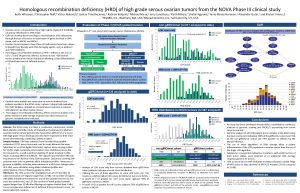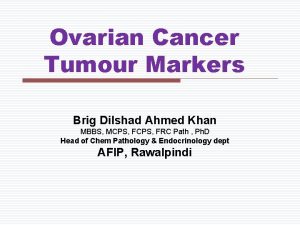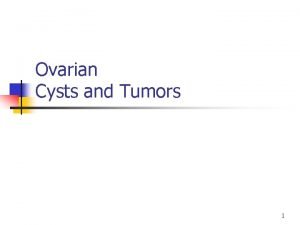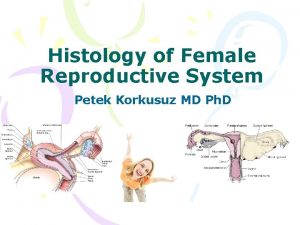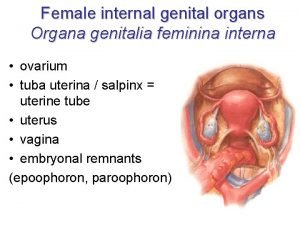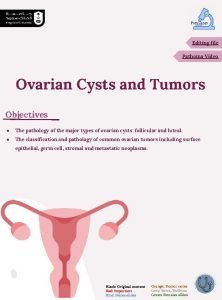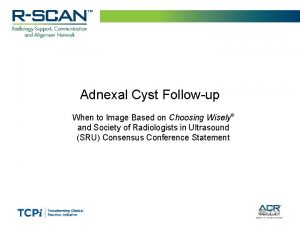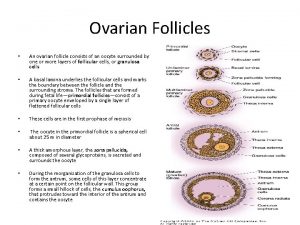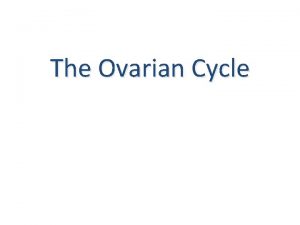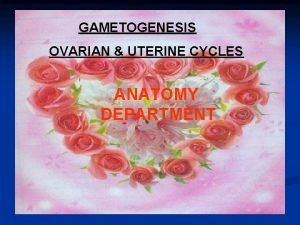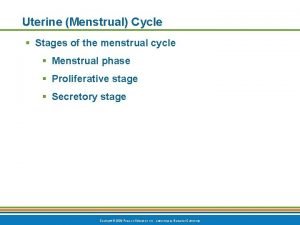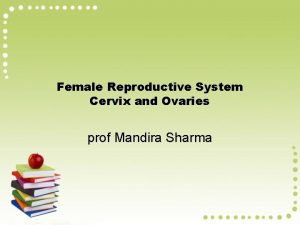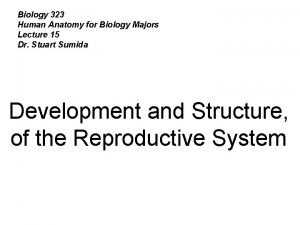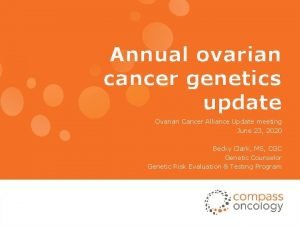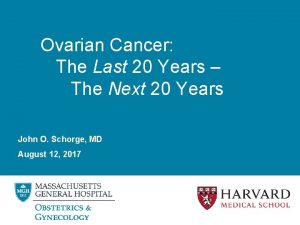Ovarian Cancer The Last 20 Years The Next






























































- Slides: 62

Ovarian Cancer: The Last 20 Years – The Next 20 Years John O. Schorge, MD August 12, 2017

Disclosures I have no disclosures to make

Ovarian Cancer uptodate. com

Ovarian Cancer • 22, 000 diagnoses each year • 15, 000 deaths in the USA • Two-thirds diagnosed with advanced disease • 80 -90% relapse rate • Each patient has a very personal story

Learning Objectives • To understand progress made in the past 20 years of ovarian cancer management • To appreciate the state-of-the-science today • To speculate on what ovarian cancer prevention & treatment will look like 20 years in the future

Ovarian Cancer

Ovarian Cancer

1997

1997 Your speaker begins his fellowship in gynecologic oncology

1997 • Fatigue and abd pain: 10 months of misdiagnosis • Stage IV disease with Xlap/suboptimal debulking • Platinum-based therapy with <1 year in remission • Bowel perf and death within 6 months of relapse

1997 • Oral contraceptives (OCs) reduce risk of ovarian cancer by inducing quiescent surface epithelium • Bilateral salpingo-oophorectomy (BSO) at time of hysterectomy in women >40 years • Prophylactic BSO in high-risk patients as identified by pedigree of familial clustering • Federal grant support of prospective large screening studies designed to foster early detection

Current state-of-the-science • OCs have prevented some 200, 000 cases of ovarian cancer worldwide over the past 50 years, but mechanism unclear Lancet Jan 2008; NCI Cancer Bulletin 2010

Current state-of-the-science Integrated model of ‘ovarian carcinogenesis’

Current state-of-the-science Growing Acceptance of Removing Fallopian Tubes But Keeping Ovaries to Lower Ovarian Cancer Risk

Current state-of-the-science • First large-scale population-based cohort study • 250, 000+ women • Bilateral salpingectomy: 50% decrease in risk of ‘ovarian cancer’ • Support the hypothesis that a substantial fraction arise in the tube

Current state-of-the-science

Current state-of-the-science • OCs have prevented some 200, 000 cases of ovarian cancer worldwide over the past 50 years, but mechanism unclear • Opportunistic bilateral salpingectomy (BS) at time of hysterectomy to reduce risk of ovarian cancer

Current state-of-the-science “Any individual with ovarian cancer warrants further genetic risk evaluation”

Current state-of-the-science • BRCA 1 • BRCA 2

Current state-of-the-science • BRCA 1 • BRCA 2 • BRIP 1 • RAD 51 C • PALB 2 • CHEK 2 • Others…

Current state-of-the-science • OCs have prevented some 200, 000 cases of ovarian cancer worldwide over the past 50 years, but mechanism unclear • Opportunistic bilateral salpingectomy (BS) at time of hysterectomy to reduce risk of ovarian cancer • Prophylactic BSO in high-risk patients as identified by genetic testing

Current state-of-the-science • RCT at 13 sites England, Wales, N Ireland • Women aged 50 -74 • 1: 1: 2 of CA 125/ROCA (MMS), USS or no screening • Enrolled 200, 000+ between 2001 -2005 • Primary outcome: death by ovarian cancer

Current state-of-the-science Regular CA 125 Test Risk of Ovarian Cancer Algorithm based on longitudinal CA 125 values (ROCA) Normal Intermediate Elevated ROCA < low < ROCA < high ROCA > high Repeat CA 125 Interval determined by ROCA TVS + CA 125

Current state-of-the-science

Current state-of-the-science

Current state-of-the-science • Despite enormous effort, there is no proof that routine screening in either the high-risk or general populations with markers, sonograms, or pelvic examinations decreases mortality. • Further evaluation is needed to determine whether any novel biomarkers, or panels of markers, have utility in early detection. Gynecol Oncol 2010

Current state-of-the-science Balance of Benefits and Harms: Annual screening with TVS and CA 125 in women does NOT decrease ovarian cancer mortality. Instead, it can lead to important harms, including major surgical interventions in women who do not have cancer. Therefore, the harms of screening for ovarian cancer outweigh the benefits. Sept 10, 2012

Current state-of-the-science

Current state-of-the-science UPDATE! Grade Population Recommendation Asymptomatic women The USPSTF recommends against screening for ovarian cancer in asymptomatic women. D This recommendation does not apply to women who are known carriers of genetic mutations that increase their risk for ovarian cancer (e. g. , BRCA 1 or BRCA 2 gene mutations). July 24, 2017

Current state-of-the-science • OCs have prevented some 200, 000 cases of ovarian cancer worldwide over the past 50 years, but mechanism unclear • Opportunistic bilateral salpingectomy (BS) at time of hysterectomy to reduce risk of ovarian cancer • Prophylactic BSO in high-risk patients as identified by genetic testing • Prospective large trials have largely failed to meaningfully impact ovarian cancer mortality rates

2017 • Ashkenazi Jewish with family hx & BRCA 1 mutation carrier • Enrolls in CA 125/TVS screening trial • Elects to have prophylactic laparoscopic BSO age 37 • Occult stage IC fallopian tube cancer identified


2037(? ) Liquid-based cervical p 53 screening of exfoliated tubal epithelium

2037(? ) Natural Orifice Transluminal Endoscopic prophylactic BS

2037(? ) • Genetic testing in childhood identifies BRCA 1 mutation • Annual liquid-based cervical p 53 screening (positive) • NOTES bilateral salpingectomy at age 33 • STIC lesion detected that does not require further treatment

2037 and beyond

Ovarian Cancer

1997

1997 Your speaker begins his fellowship in gynecologic oncology

1997 • Ann Dunham developed stomach pains abroad 1994 • Months of misdiagnosis until ovarian cancer suspected • Stage IV disease s/p suboptimal debulk with prolonged course • Platinum-based treatment with early relapse and death age 52

1997 • Advanced ovarian cancer patients 1 st undergo vertical laparotomy with debulking surgery • Postoperatively, IV carboplatin and paclitaxel chemotherapy x 6 cycles • NCI collaborative group trials of large phase III chemotherapy trials ongoing • Relapsed disease managed with a provider-specific sequence of 3 or 4 cytotoxic chemo drugs

Current state-of-the-science Sept 2010

Current state-of-the-science

Current state-of-the-science 1. 00 MGH primary debulking OVCA: Jan 2000 – Dec 2009 No Residual Disease Median OS = 69 mo P < 0. 001 0. 75 Optimal ≤ 1 cm Median OS = 38 mo Suboptimal > 1 cm Median OS = 22 mo 0. 00 0. 25 0. 50 R 0 0 5 Years 10 15

Current state-of-the-science

Current state-of-the-science Laparoscopic scoring to predict resectability (to R 0)

Current state-of-the-science

Current state-of-the-science Fagotti/MDACC Lscopic scoring (SGO-2016) • 99 pts advanced ovarian cancer (34 excluded) • 65 had laparoscopy • 40 had score <8: 37 PDS 86% R 0 • 25 had score 8+: NAC 78% R 0

Current state-of-the-science • Intraperitoneal chemotherapy • 16 -month survival advantage • Rare NCI clinical announcement • Time-table to study completion Jan 2006

Current state-of-the-science Leaner randomized phase II trials run via consolidated collaborative group (NRG Oncology)

Current state-of-the-science Leaner randomized phase II trials run via consolidated collaborative group (NRG Oncology) NRG-GY 007 Phase I dose-escalation study of ruxolitinib – followed by randomized phase II component Oral JAK 1/2 inhibitor Testing dose-dense carbo/paclitaxel Testing maintenance therapy Testing translational endpoints with longitudinal tissue 162 patient sample size

2017 • (Still) months of misdiagnosis until ovarian cancer suspected • Stage IV disease s/p bx and phase II NAC/immunotherapy trial • Interval minimally invasive (optimal) cytoreductive surgery • Investigational maintenance therapy in remission per protocol


2037(? ) • Histologic confirmation serous cancer • Next. Gen molecular profiling of tumors

2037(? ) • Histologic confirmation serous cancer • Next. Gen molecular profiling of tumors

2037(? ) • Histologic confirmation serous cancer • Next. Gen molecular profiling of tumors • Laparotomy with primary debulking • Minimally invasive surgery only

2037(? ) • Histologic confirmation serous cancer • Next. Gen molecular profiling of tumors • Laparotomy with primary debulking • Minimally invasive surgery only • Platinum/paclitaxel and novel drug trials • Patient triage based on specific predictors

2037(? ) • Histologic confirmation serous cancer • Next. Gen molecular profiling of tumors • Laparotomy with primary debulking • Minimally invasive surgery only • Platinum/paclitaxel and novel drug trials • Patient triage based on specific predictors • Achieve remission and wait for relapse • Maintenance therapy to prolong remission

2037(? ) • Pelvic symptoms prompt diagnostic workup • Stage IIIC disease s/p bx and comprehensive molecular profile • Neoadjuvant oral combination of BRIP 1/JAK 2 inhibitor • Minimally invasive day-surgery with revision of therapy based on translational tumor response

2037 and beyond

Learning Objectives ü To understand progress made in the past 20 years of ovarian cancer management ü To appreciate the state-of-the-science today ü To speculate on what ovarian cancer prevention & treatment will look like 20 years in the future

Thank you
 Ovarian cancer causes
Ovarian cancer causes Ovarian cancer brca
Ovarian cancer brca Hrd score ovarian cancer
Hrd score ovarian cancer Ovarian cancer marker
Ovarian cancer marker X.next = x.next.next
X.next = x.next.next Sheep years to human years
Sheep years to human years 300 solar years to lunar years
300 solar years to lunar years Where is this image from
Where is this image from The ovarian cycle
The ovarian cycle Ovarian teratoma
Ovarian teratoma Primordial follicle
Primordial follicle Fuctions of ovary
Fuctions of ovary Ovarian benign tumor
Ovarian benign tumor Leydig cells produce
Leydig cells produce Chapter 16 the reproductive system
Chapter 16 the reproductive system Corona radiata
Corona radiata Female reproductive system
Female reproductive system Ovarian cyst size chart comparison
Ovarian cyst size chart comparison Sru consensus ovarian cysts
Sru consensus ovarian cysts Ovarian follicle
Ovarian follicle Follicles in ovary
Follicles in ovary Oogonium
Oogonium Ovarian cyst rupture discharge look like
Ovarian cyst rupture discharge look like Ovarian cycle
Ovarian cycle Ovarian cycle
Ovarian cycle Ovarian cyst
Ovarian cyst Ovarian ligament
Ovarian ligament Duck penis
Duck penis Female reproductive system
Female reproductive system Last seven years
Last seven years Lời thề hippocrates
Lời thề hippocrates Vẽ hình chiếu đứng bằng cạnh của vật thể
Vẽ hình chiếu đứng bằng cạnh của vật thể Phản ứng thế ankan
Phản ứng thế ankan Quá trình desamine hóa có thể tạo ra
Quá trình desamine hóa có thể tạo ra Các môn thể thao bắt đầu bằng tiếng đua
Các môn thể thao bắt đầu bằng tiếng đua Hình ảnh bộ gõ cơ thể búng tay
Hình ảnh bộ gõ cơ thể búng tay Khi nào hổ mẹ dạy hổ con săn mồi
Khi nào hổ mẹ dạy hổ con săn mồi Dạng đột biến một nhiễm là
Dạng đột biến một nhiễm là điện thế nghỉ
điện thế nghỉ Nguyên nhân của sự mỏi cơ sinh 8
Nguyên nhân của sự mỏi cơ sinh 8 Trời xanh đây là của chúng ta thể thơ
Trời xanh đây là của chúng ta thể thơ Voi kéo gỗ như thế nào
Voi kéo gỗ như thế nào Thiếu nhi thế giới liên hoan
Thiếu nhi thế giới liên hoan Fecboak
Fecboak Một số thể thơ truyền thống
Một số thể thơ truyền thống Thế nào là hệ số cao nhất
Thế nào là hệ số cao nhất Slidetodoc
Slidetodoc Sơ đồ cơ thể người
Sơ đồ cơ thể người Tư thế ngồi viết
Tư thế ngồi viết Số nguyên là gì
Số nguyên là gì đặc điểm cơ thể của người tối cổ
đặc điểm cơ thể của người tối cổ Các châu lục và đại dương trên thế giới
Các châu lục và đại dương trên thế giới Mật thư anh em như thể tay chân
Mật thư anh em như thể tay chân Tư thế worm breton
Tư thế worm breton ưu thế lai là gì
ưu thế lai là gì Thẻ vin
Thẻ vin Cái miệng nó xinh thế chỉ nói điều hay thôi
Cái miệng nó xinh thế chỉ nói điều hay thôi Các châu lục và đại dương trên thế giới
Các châu lục và đại dương trên thế giới Bổ thể
Bổ thể Từ ngữ thể hiện lòng nhân hậu
Từ ngữ thể hiện lòng nhân hậu Tư thế ngồi viết
Tư thế ngồi viết V. c c
V. c c Thơ thất ngôn tứ tuyệt đường luật
Thơ thất ngôn tứ tuyệt đường luật


